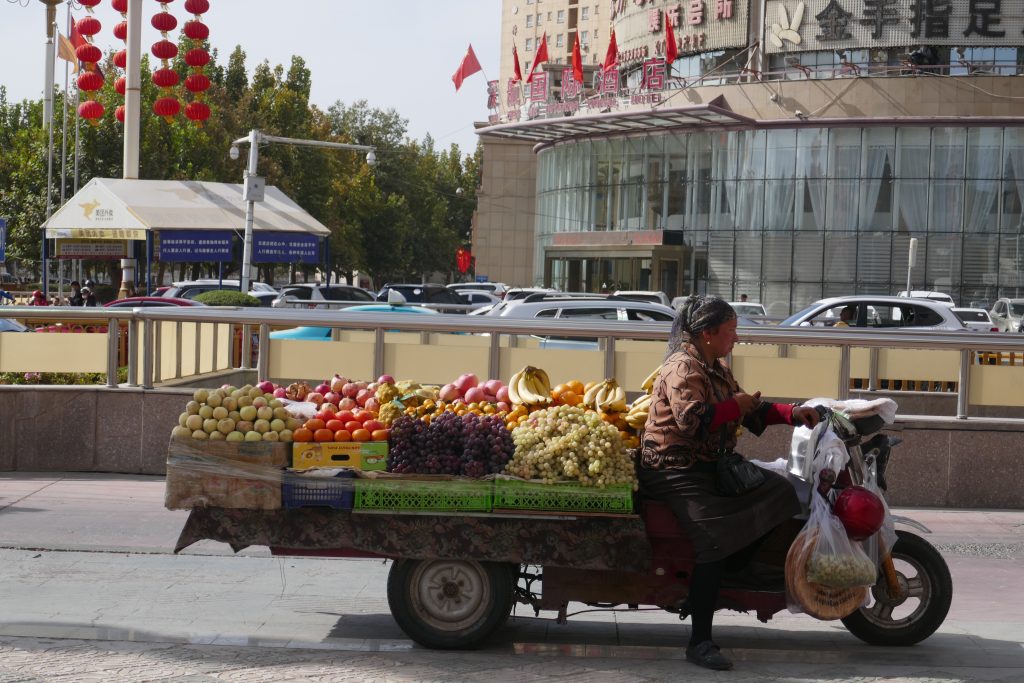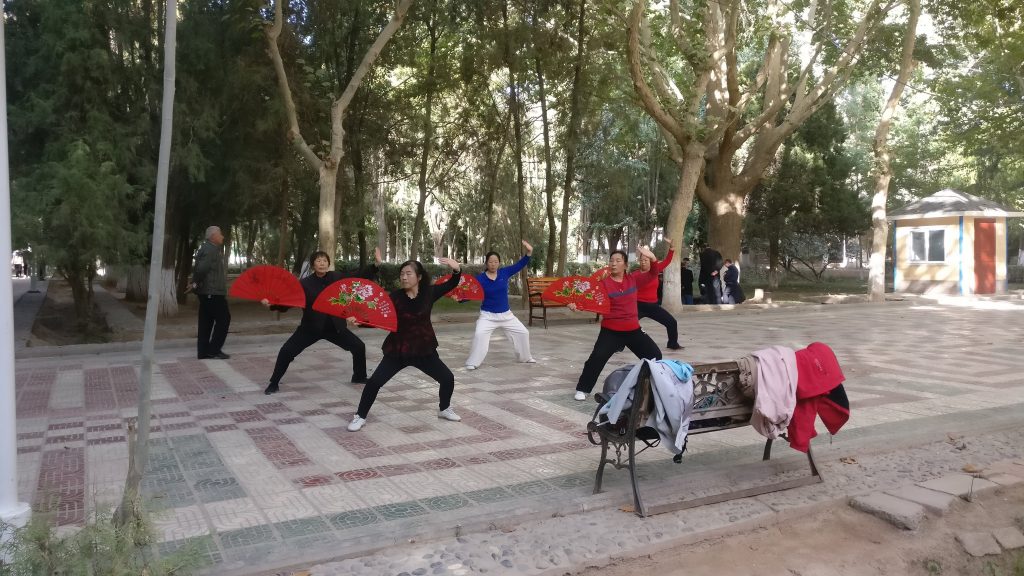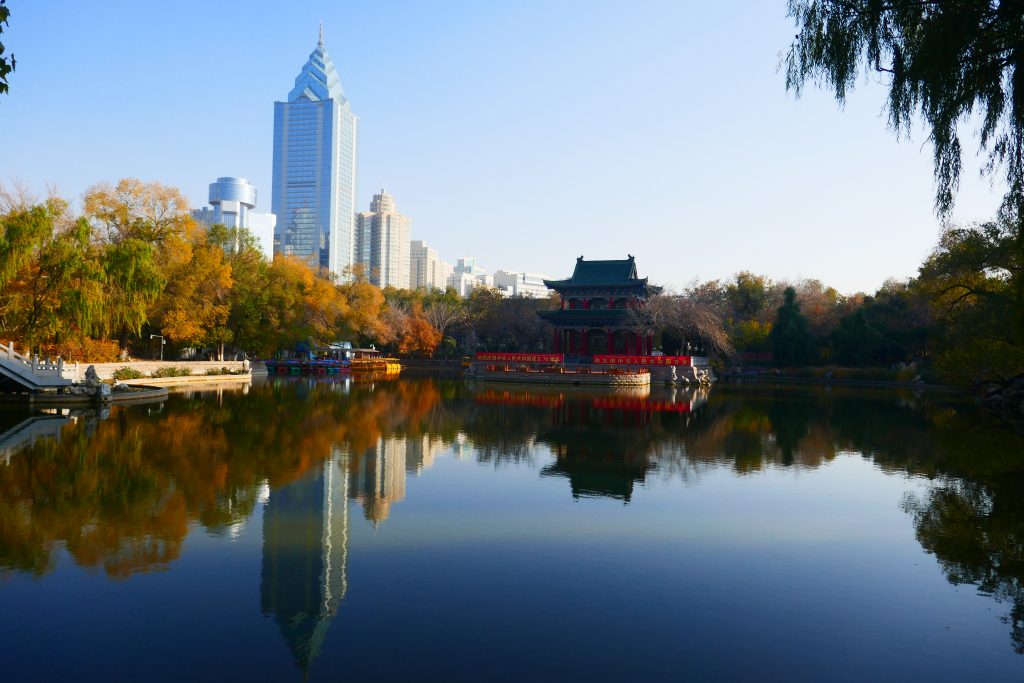In this article you will find some of the relevant episodes that characterized our visit of Xinjiang. If you want to know more about the region, have a look at our articles about Irkhestam pass or what you need to know before you go there.
Our experience in far west China…
We spent a week in Xinjiang and we went to Kashgar, Kuqa and Urumqi. Our original plan didn’t include Kuqa but then we decided to stop over just for a couple of days in order to break the journey between Kashgar and Urumqi (over 24h by train) and visit a small city in such remote areas.
KASHGAR, important and historical city along the Silk Road, was the main reason why we decided to cross the Irkhestam border. We booked a bed in a dorm at the Kashi Maitian hostel (it took ages to find the proper location, we updated it on maps.me) but if you actually go there without reservation private rooms cost as much as two beds in dorms. The city of Kashgar has become extremely touristy over the last few years particularly among Chinese people, who come from mainland China to see such a remote and historical city in the far west of their country.

However, as often happens in China, the “old city” doesn’t seem to be particularly old since it has been totally reconstructed and you need a lot of imagination to realize that it used to be the famous oasis along the Silk Road.

When we were there, there was still a not reconstructed portion of the ancient city but, obviously, the access was restricted and in a few years time it will probably be renewed it as well. Although modern and touristy, Kashgar is still a nice place to visit and a very different city compared to the rest of China. Having dinner at the night market (closes at 11pm Beijing time/9pm Xinjiang time), visiting Id Kah mosque and climbing up to the pagoda, from which you will have a nice view of the city, are probably the three not-to-miss experiences of the old city.

On the other hand, the new town is not really appealing, except a couple of parks, but it’s nice to walk around and see how the “real Kashgar” looks like.


2019 was also the 70th anniversary of the foundation of the People’s Republic of China so everywhere you could see flags and symbols that reminded you this important date.

However, what characterizes Kashgar the most is the number of cameras controlling every single movement of every single person. Cameras are everywhere and are able to recognize your face but, if they are unable to do so, they will start following you. It happened to us, creepy….

————
KUQA (or Kuche) is a city in between Kashgar and Urumqi and was once the homeland of the ancient Buddhist Kingdom of Kucha. We decided to go there just when we realised that it would have taken such a long time to go from Kashgar to Urumqi and because we actually wanted to spend more time in the Xinjiang province. Travelling in Kuqa revealed to be the toughest experience of the Silk Road, along with Ashgabat in Turkmenistan. When we arrived, we were escorted by the police to one of the three hotels in the whole city (470000 inhabitants) that accepted foreigners. We had to bargain a lot but we eventually managed to get a room for a reasonable price; at the end we didn’t have choice but going there since the other two hotels were very fancy ones.
In Kuqa, according to our travel guide, there are four sights of interest: a palace, the old city, a mosque and a canyon nearby the city. Since our hotel was far from the city centre, we decided to get a taxi so we went to the main road but no one was stopping. At some point a car (not a taxi) stopped in front of us and we realised that we saw one of the two people in the car when we exited the hotel…suspicious we thought…. Arrived at the palace, the driver offered us a lift for a good price for the next day to the canyon so we agreed. The palace would be nice if it was well maintained but since it’s kind of abandoned and all the explanations are written in Chinese you won’t miss much if you don’t go there (unless you speak Chinese, of course).

After the palace, we tried to visit the old town but it was impossible. All the accesses to the old town were closed with gates, armed guards prohibited us to pass, local people were locked inside and had to be registered every time they wanted to get out or to go home.

Tourists could only follow one road (very nice and reconstructed, of course) to go from the palace to the mosque. In the occasion, we were registered and followed by two individuals who controlled our movements and waited us outside the mosque as well.

The day after we went to the nice canyon out of Kuqa with the “driver” of the day before and we started noticing a few unusual things that made us suspecting he was actually a policeman.

He claimed to be Uighur but he didn’t have GPS, camera or microphones in his car. We asked some explanations and he told us that it was his friend’s car. Moreover, on the way back from the canyon, he asked “do you need a lift to the train station tonight?”…how did he know that we were leaving that night? We didn’t tell him anything! At the point, we genuinely started thinking that he was a policeman who had been following us the all time and the puzzle was completed when we arrived at the train station, where he greeted the policemen as he was his friend. Uighur people are not that friendly with Chinese policemen…
———
URUMQI was definitely the easiest part of our journey in Xinjiang. At the arrival we were obviously registered (the policeman who registered us even confused the Turkmen visa with the Chinese one) but they didn’t ask many questions. We were neither followed nor escorted by police anywhere or, at least, we didn’t notice anything. As west gate of the Chinese belt and road initiative and capital of the Xinjiang province, the city of Urumqi has been extraordinarily developed over the last few years and it is one of the symbols of the Chinese economic miracle. Until 1950, Urumqi was just a little town in far west China while now it’s a modern city where skyscrapers have replaced the short traditional houses.

We didn’t have great expectations about Urumqi but the visit revealed to be more pleasant than what we thought. Walking around parks in Urumqi was probably what we appreciated the most and Hongshan and Renmin parks are the most notable ones.

At the top of the first one, you will find a pagoda and a temple, two of the oldest monuments of the city, while in renmin park you will find beautiful pagodas, people singing traditional songs or playing table tennis (we later realised that all this was very common in China). Finally, the Xinjiang museum will give you the opportunity to see some creepy mummies discovered in the region as well as read a bit about Xinjiang from the Chinese government point of view.

Overall we were glad we travelled in such remote and complex region and, despite being constantly hassled by the police, we were happy to have personally seen what’s going on in the far west of China. We didn’t hear any particularly bad story from tourists when we were there but it has definitely been one of the toughest places we visited on our journey from Milan to Beijing. We hope that sharing our experiences and giving you some information about what to expect may help you to be prepared and fully enjoy the visit to such a beautiful and remote land.




